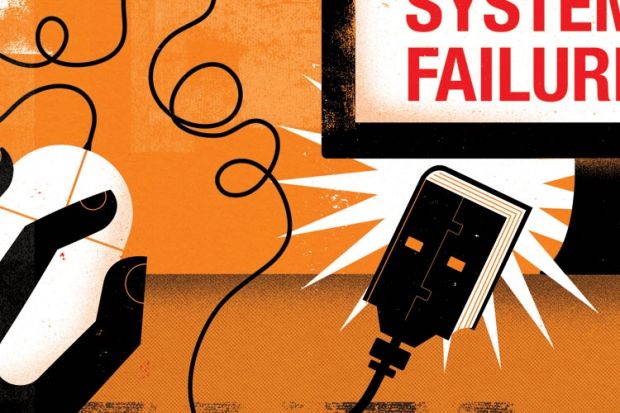Source: Dale Edwin Murray
Moocs will not solve the problem of expensive undergraduate education or educational scarcity in emerging economies. This is just a cruel myth
In last week’s Times Higher Education, University of Greenwich vice-chancellor David Maguire called massive open online courses the most-hyped new idea in higher education in 2013. He predicted that a “trough of disillusionment” would open up in 2014.
Well he might. Free online courses that require no prior qualifications or fee are a wonderful idea but are not viable.
Mooc students spend the majority of their study time watching videos and reading. To aid understanding they join discussion groups with other students, and they take computer-marked tests that direct them back to material they have not understood. For feedback they exchange assignments with a partner and peer grade them against a set of criteria.
Moocs are depicted as a disruptive technology because they involve no ongoing teaching expenses and cost the same to run no matter how many students enrol. But the idea that “content is free” in education is one of several myths that have helped to inflate the bubble of hype. Yes, there is a mass of free material on the web. But for educational purposes, web content has to be curated by someone who knows how it relates to an intended learning outcome, and their work does not come free. Video content could of course be the by-product of a lecture that is already part of a course, but for online students with no prior qualifications it would have no meaning. Video content for them would have to be specially developed – and funded.
Another myth is that students can support each other. UK universities maintain a staff-to-student ratio of roughly 1:25. This means that if you have 25 students on a course it will take at least one tutor to advise, guide and assess them. Even the largest Open University courses operate on this basis. Harvard Law School uses the edX platform for its course on copyright, but limits enrolment to 500 because it has only 21 tutors and knows – as it says on its website – that “high-quality legal education depends, at least in part, upon supervised small-group discussions of difficult issues”. A Duke University Mooc that began with 12,000 students used only 200 hours of tutor time. But the number of students requiring support for the eight or so hours they spent in tutored discussions and assignments was around 500 by the halfway point: roughly a 1:20 ratio.
Nor will Moocs solve the problem of expensive undergraduate education or educational scarcity in emerging economies. This is just a cruel myth. Evidence from several universities suggests that well over 60 per cent of those who register for Moocs already have degrees (although the reports do not include demographic data on the few who complete). So Moocs do not provide an opportunity to discover how to teach first-time undergraduates successfully in an online format.
It is true that university education in its current form completely fails to meet the worldwide demand, currently estimated at 100 million potential students each year, primarily from emerging economies. But our fully developed economies do not meet even the domestic demand for well-educated graduates. So why are our top universities spending millions to provide free and (they claim) innovative courses for global students who turn out to be already highly qualified professionals? Once they have benefited from the contribution of Moocs to their reputation and marketing campaigns, universities claim they will be able to pass on the innovation to their own undergraduates. But why were their undergraduates, who pay thousands of pounds in fees, not worthy of such investment before? These technologies have been available to universities for many years.
The simple fact is that a course format that copes with large numbers by relying on peer support and assessment is not an undergraduate education. Education is not a mass customer industry: it is a personal client industry. The significant initial investment required in the preparation of educational resources can be distributed over very large student numbers and repeated runs of the course, but education is fundamentally about learning concepts and skills that we do not acquire naturally through our normal interaction with the world. And this takes time. It requires personalised guidance, which is simply not scalable in the same way. This is what the private educational sector continues to ignore, and it is why every new idea for solving the problem of mass education with technology falls flat.
So if we support students on a roughly 1:25 staff-to-student ratio and we increase our student numbers by hundreds of thousands, where are those thousands of tutors to come from? That is not a rhetorical question; there are ways of answering it. We could be exploring new structures for higher education. But the simplistic myths of Moocs are not the answer.
The model has value for professional development, providing a forum for the dissemination, discussion and development of up-to-date ideas. It could even be used to help academics, teachers and policymakers make technology work in education, and develop effective ways of tackling that huge unmet demand for higher education. Only then would vice-chancellors’ excitement about the hundreds of thousands of students registered on their Moocs – dwarfing their campus cohorts – be justified.
But I have had many opportunities to observe that very intelligent people leave their brains behind when it comes to technology. The Mooc phenomenon is just further confirmation of that simple truth.
Register to continue
Why register?
- Registration is free and only takes a moment
- Once registered, you can read 3 articles a month
- Sign up for our newsletter
Subscribe
Or subscribe for unlimited access to:
- Unlimited access to news, views, insights & reviews
- Digital editions
- Digital access to THE’s university and college rankings analysis
Already registered or a current subscriber? Login





